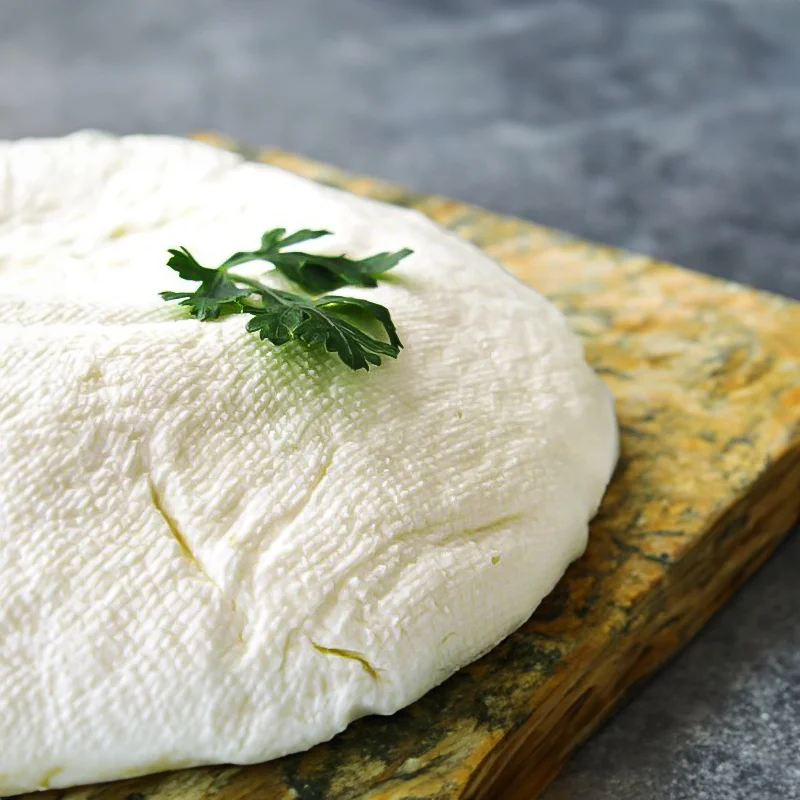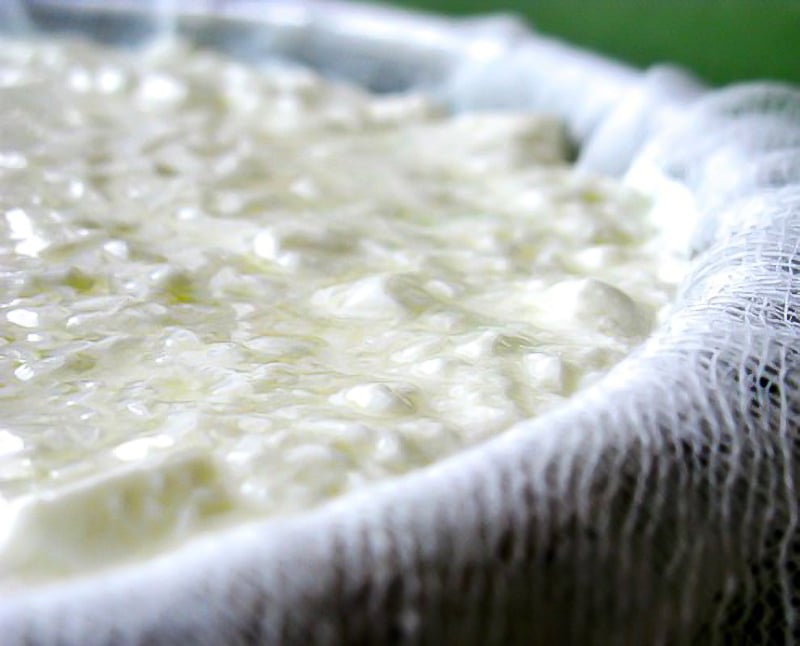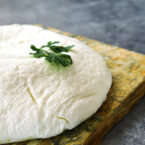Basa cheese is a traditional Croatian delicacy originating from the mountainous region of Lika. This simple, homemade cheese is made from whole milk and sour cream, creating a creamy and versatile spread.
If you’ve never been to Croatia and decide to visit, you’ll probably opt for the coastal regions and old towns like Dubrovnik. However, there’s a beautiful gem situated in central Croatia, nestled behind the Velebit mountain range—Lika.
Lika is a mountainous region full of both explored and unexplored beauty. If you visit this part of Croatia, be sure to take time to explore stunning sites like Plitvice Lakes National Park (a UNESCO World Heritage site since 1979), The Northern Velebit National Park, the spring of the Gacka River, and various other natural wonders.
Lika is very dear to my heart because my grandfather was born there, and I have many beautiful childhood memories connected to this area. The region’s cuisine has emerged from its lifestyle, with an abundance of pasture-grounds and forests. Summers are short, and winters are cold with plenty of snow, resulting in a cuisine characterized by simplicity—meals cooked over an open fire, like lamb, polenta, potato halves, sauerkraut, and various types of cheese. The two most renowned cheeses are Basa and Škripavac. Also, the forest honey of Lika is of the highest quality and is well known throughout the country.
Basa is usually made from cow’s milk, sometimes combined with sheep’s milk. When I told my grandpa about my attempt to recreate the famous cheese, he got very excited. The pressure was on: would I be able to produce a cheese decent enough to be called “cheese from Lika,” and would my grandpa approve?
It turned out perfectly, and was given an official Basa stamp of approval by my grandfather. So now, Basa can make its way into kitchens across the globe. It is incredibly easy to make, a very creamy and versatile spread and works super well in both savory and sweet dishes.

Step-by-Step Guide to Making Croatian Basa Cheese
Prepare the Milk
- Boil the Milk: Pour the whole milk into a large pot and heat it until it reaches a rolling boil.
- Cool the Milk: Remove the pot from the heat and let the milk cool until it is tepid.
Mix in the Sour Cream
- Add Sour Cream: Once the milk has cooled to a tepid temperature, stir in the sour cream until fully incorporated.
- Cover and Wrap: Cover the pot with a lid and wrap it in a kitchen towel to keep it warm. Leave it in a warm place overnight.
Strain the Cheese 
- Prepare the Strainer: Line a strainer with a clean cheesecloth and place it inside a large bowl.
- Drain the Whey: Pour the tepid milk mixture into the cheesecloth-lined strainer. The mixture will have a pudding-like consistency.
- Stir Gently: Gently stir the mixture to help drain off the whey.
- Refrigerate: Fold the ends of the cheesecloth over the cheese and place the strainer and bowl in the refrigerator. Let it drain for a couple of hours.
Final Touches
- Collect Whey: Occasionally collect the drained whey. You can use it in smoothies or other recipes.
- Decide Consistency: The longer you leave the cheese to drain, the firmer it will become. Decide whether you want a firmer or creamier cheese and adjust the draining time accordingly.
- Remove and Store: Carefully remove the cheese from the cheesecloth. If using it in savory dishes, add salt to taste. For sweet dishes, leave it unsalted.
Recipe Notes
- Consistency: For a creamier cheese, drain for a shorter period. For a firmer cheese, drain longer.
- Whey Usage: Don’t discard the whey. It’s nutritious and can be used in various recipes or consumed as a drink.
- Serving Suggestions: Use as a spread on bread, in savory dishes, or in cheesecakes.

How to Make Croatian Basa Cheese
- Total Time: 12 hours 25 minutes
- Yield: 2 cups 1x
Description
Basa cheese is a traditional Croatian delicacy originating from the mountainous region of Lika. This simple, homemade cheese is made from whole milk and sour cream, creating a creamy and versatile spread.
Ingredients
- 4 pints (2 liters) whole milk
- 0.4 pint (200 ml) sour cream
- Salt (to taste)
Instructions
Prepare the Milk
- Boil the Milk: Pour the whole milk into a large pot and heat it until it reaches a rolling boil.
- Cool the Milk: Remove the pot from the heat and let the milk cool until it is tepid.
Mix in the Sour Cream
- Add Sour Cream: Once the milk has cooled to a tepid temperature, stir in the sour cream until fully incorporated.
- Cover and Wrap: Cover the pot with a lid and wrap it in a kitchen towel to keep it warm. Leave it in a warm place overnight.
Strain the Cheese
- Prepare the Strainer: Line a strainer with a clean cheesecloth and place it inside a large bowl.
- Drain the Whey: Pour the tepid milk mixture into the cheesecloth-lined strainer. The mixture will have a pudding-like consistency.
- Stir Gently: Gently stir the mixture to help drain off the whey.
- Refrigerate: Fold the ends of the cheesecloth over the cheese and place the strainer and bowl in the refrigerator. Let it drain for a couple of hours.
Final Touches
- Collect Whey: Occasionally collect the drained whey. You can use it in smoothies or other recipes.
- Decide Consistency: The longer you leave the cheese to drain, the firmer it will become. Decide whether you want a firmer or creamier cheese and adjust the draining time accordingly.
- Remove and Store: Carefully remove the cheese from the cheesecloth. If using it in savory dishes, add salt to taste. For sweet dishes, leave it unsalted.
Notes
- Consistency: For a creamier cheese, drain for a shorter period. For a firmer cheese, drain longer.
- Whey Usage: Don’t discard the whey. It’s nutritious and can be used in various recipes or consumed as a drink.
- Serving Suggestions: Use as a spread on bread, in savory dishes, or in cheesecakes.
- Prep Time: 10 min
- Draining and Setting: 12 hours
- Cook Time: 15 min
Nutrition
- Serving Size: 50g
- Calories: 200
- Sugar: 5g
- Sodium: 70mg
- Fat: 8g
- Saturated Fat: 5g
- Unsaturated Fat: 3g
- Trans Fat: 0g
- Carbohydrates: 6g
- Fiber: 0g
- Protein: 6g
- Cholesterol: 25mg












I added some garlic and herbs to the cheese, and it turned out delicious. A new favorite in our house!
Attempting homemade cheese for the first time. If I succeed, I’m buying a cow next!
EDIT: Cheese turned out perfectly. Looking for cow on Cragslist.
Making this Basa cheese had me feeling like a Croatian dairy farmer, minus the pitchfork. Truly an awesome recipe, very easy to succeed with and the cheese is so delicious!
It sounds so wonderful &simple to make. I will definitely make it, Iam Greek and just love cheeses and your cuisine, which has a lot of similarities!!?
My family comes from Ramljane in Lika. My Mom made polenta different than polenta from Other areas. It was dryer and crumbly and served with sauteed Sauer kraut. Delicious. How can I get the recipe for this dish?
Habla,
Helen
Can someone tell me how long this will last in the fridge? It is only myself and my husband eating this.
Also, How much will this recipe make? I would like to try to use it to make a cheese cake and I need 24 oz.
Thanks!
Basa cheese will typically last for up to one week when stored in an airtight container in the refrigerator. The recipe makes about 2 cups. Hope you like it! :D
Hi Tamara , I’m so glad to have found your page my patents to ate from Lika , Saborsko in fact and we always and still do eat traditional meals home made . I can’t wait to show my mum this recipe and I will definitely be trying it . Thank you for sharing . Xx
How much is “some salt”? Can you be a little more specific? I would appreciate it. I really wanna make this cheese. Sounds delicious!
It is basically “to taste”, but a pinch or two is a good start. :D
:))
veliki pozdrav iz karlovca!
@ Tamara: Lots of Croatians in Canada…. (Nisu slusali onaj vic o kanadi kad je mujo doso u Kanadu) ;)
Pozdrav iz Winnipeg, Manitoba Kanada!
I puno hvla na recepte!
Pozzzz
p.s. my grandmother’s family immigrated to Canada as well, sounds like lots of Croatians are there :)
Totally agree with you :) Thank you for sharing!
Best,
Tamara
Hi Tamara,
My grandparents and mother were all born in Lika and immigrated to Canada. It’s nice to know someone out there in Internet land is making this region known–but I hope not too well-known as it’s a rare gem! Thank you.
Best regards,
Janet
This cheese is great… my father and I make it all the time except my tata calls it “domaci sir”. Now i can ask him if it’s actually called basa!
This is the cheese my grandmother would make for her strukli.
Thank you for the happy memories as I browse these recipes.
Hi, We had people from croatia living down the road from us. They made a cheese I have never been able to duplicate. It was made from cows milk. When finished it was very dry (almost crumbly) and they dried it outside on cheese cloth. It was rather tart, somewhat like buttermilk in flavor. I loved it but have never found it anywhere. I have made cheese many times but have never made it like theirs. Any ideas? Thanks Mike
So nice Tamara :)
Glad to see this from downunder Australia my folks are from here Zavalje…
Ivan, glad you left the comment! I was in Lika just the other day, visiting my relatives. Most of them emigrated to Canada, but some are still here :)
I made it twice and it is a shame if any one reading this skips this fantastic recipe. Very easy to make. It practically makes itself. Fantastic recipe!
I am so glad it turned out to be great
If my mom had known how to make home made basa cheese we would not have yearned for white fresh cheese for so long. Bravo!
ps I am thinking of a period spent in the States
Very nice cheese indeed! So simple, yet so rewarding to do your own…
In my latest book “Got Cheese?” I am also trying to inspire people to do their own cheeses at home and use it to make the best desserts possible! :-)
Glad you like it!
I totally agree, people should try and make more homemade cheese, once you get to it, you realize it is actually simple :)